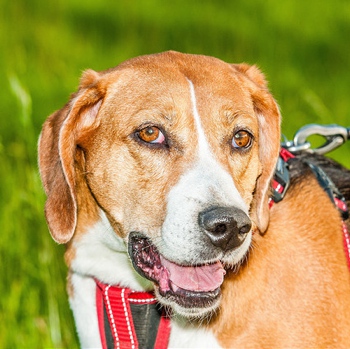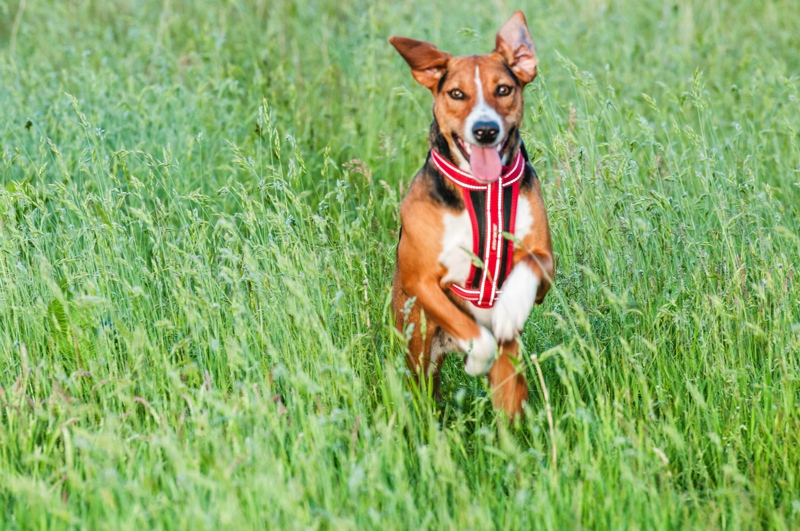Hamiltonstövare

This handsome, athletic dog hails from Sweden, where it was developed with the slightly unusual aim of creating a hound that would work alone rather than as part of a pack. Given this background, it is natural that it can be slightly less gregarious than other hound breeds, such as the Foxhound, which was involved in its creation, but it is generally an easy-going, amiable dog that is always happy to meet new people. Like many of the hound breeds, it is not ideally suited to the novice owner, for it needs a person whom it can identify as being a strong and confident pack leader, and is likely to go through a period of challenging behaviour during its adolescent phase that needs to be handled with a firm but reasonable approach. It is good with children, but has a very high prey drive, and cannot be trusted with small pets, including very small dogs.
This is an extremely active breed, capable of hunting for an entire day with little or no rest, and needs lots of exercise if it is to be a healthy and contented pet. The svelte physique of a healthy Hamiltonstövare reflects a balance between good quality food and a great deal of physical activity, and inactive individuals are likely to become obese, as well as demonstrating a range of undesirable behaviours borne out of frustration and boredom. Although it may be prone to epilepsy and some orthopaedic issues, it is a robustly healthy breed with a life expectancy of 13 to 14 years.
About & History
Although hunting remained the preserve of the nobility in Sweden until the late eighteenth century, the lifting of the ban on hunting by the peasantry in 1789 created a sharp increase in the demand for hunting dogs in the country, with scenthounds being particularly popular for fox and boar hunting. These hounds were mostly derived from continental European dogs that returned home with Swedish soldiers having toured abroad during the various wars of the previous two centuries. Almost 200 such dogs were presented for judging at the very first Swedish dog show in 1886, including two, called Pang and Stella, belonging to Count Adolf Patrik Hamilton, who are believed to have provided the foundation for the breed. Along with Pang and Stella, the Count is thought to have used other scenthounds, including the Bloodhound, Foxhound, and Harrier, in the creation of this new breed with a keen nose, strong hunting instinct, and high levels of fitness and endurance, which was initially called the Swedish Hound.
In 1921, eleven years after the Count’s death, the breed was renamed the Hamiltonstövare in his honour. It is used as an individual hunting dog, tracking and flushing game from cover for its master. Its physical attributes reflect its hunting style, as its rangy legs can cover ground quickly, while its long neck allows it to keep its acute nose on a trail even at high speed. It also has an impressively loud voice, allowing it to attract its owner’s attention from a great distance when its quarry is located. Although the breed is widely used in Scandinavia for its original purpose, it is quite rare in much of the rest of Europe, including the United Kingdom, where only a handful of Hamiltonstövares are registered by the Kennel Club each year.
Appearance

The Hamiltonstövare is a strong but elegant dog, tall and lean, with an upright posture. It is well-proportioned and never heavy or bulky, and there is a marked difference in appearance between males and females. It has a long head with an arched skull and well-defined stop. The muzzle is long, broad, and rectangular in outline. It has a flat bridge that runs perfectly parallel to the top of the skull. The lips are thin and tight, with no flew showing at the corners of the mouth, and the cheeks are lean and almost drawn in. As befits a hunter, it should have large, strong teeth that meet in a neat scissor bite. The dark brown eyes usually convey a serene expression, and the moderately long ears have rounded edges and are set quite high on the head.
The neck is long, with tight-fitting but supple skin. In males, it has an abundance of muscle, but is markedly more slender and refined in females. The withers are clearly defined, and the top line of the back is straight and level. The loin is powerful and arched, and it leads to a long, sloping croup. The chest is deep and long, but not excessively broad, and the abdomen should be noticeably tucked. The tail is set in line with the back, and is carried sabre-like at or below the horizontal.
While the limbs are strong and athletic, they are not heavily muscled, but are long, straight, and strongly boned. The shoulder joint is well laid back, a feature that again comes into play when the dog is following a scent with its head down. The breed moves with a long, even stride, with the legs on either side moving along parallel planes. The Hamiltonstövare has a short, harsh coat that protects its skin from rough vegetation, and exhibits a tricolour pattern of colouration: black, tan, and white, with the white forming distinct patches in a blaze along the middle of the face, the neck, and the paws.
Male Hamiltonstövares should be between 53 and 61 cm (21–24 in) tall at the top of the withers, and weigh 25–28 kg (55–62 lb), while females are 49 to 57 cm (19–23 in) in height, and weigh 23–26 kg (51–58 lb).
Character & Temperament
The Hamiltonstövare is a happy and mild-mannered dog, though it has bundles of energy, and has the potential to be somewhat skittish if under-stimulated. It is extremely friendly and sociable towards people, and is little use as a guard-dog, but it does have a loud, baying voice that may prove to be a deterrent for less determined intruders.
It can be stubborn, with a self-confidence that can result in it challenging its owner, particularly in adolescence. It is for this reason that the breed needs a home with at least one experienced owner, who can recognise and handle such behaviour. However, when appropriately managed, this is a gentle, pleasant and intelligent dog, and one that will get along with children. However, it should never be mixed with smaller, non-canine pets that are likely to trigger its ingrained hunting instincts.
Trainability
The Hamiltonstövare is reasonably easy to train; while being somewhat stubborn, it is also keen to please its master, and by breaking its training into short sessions, initiated from a young age, one should expect to see rapid results.
Health
This is a healthy breed, suffering very few inherited illnesses. However, its active lifestyle does render it susceptible to injuries, cruciate ligament rupture being the most significant of these.
Cruciate Ligament Rupture
The ligament responsible for keeping the knee stable as it flexes comes under great strain in sporting dogs, and the Hamiltonstövare may be prone to tearing this structure when working over rough ground. This will result in severe lameness, and requires surgical repair to allow a return to normal function.
Epilepsy
This is one of several breeds in which a familial form of epilepsy may exist. Signs are first seen somewhere between six months and five years of age, and most often involve intermittent episodes of convulsive seizures.
Hip Dysplasia
Like many breeds, the Hamiltonstövare may inherit a malformation of the hip joints, which manifests in pups less than a year old as intermittent or persistent lameness. While this may be managed either medically or surgically, affected dogs are unlikely to be fit for hunting.
Exercise and Activity Levels
As a working dog, the Hamiltonstövare has been bred to be extraordinarily fit and active. Although it is generally calm and laid-back at home, it needs two long walks each day to allow it to burn off surplus energy and to maintain a healthy body weight.
Grooming
The short coat requires little grooming, and once-weekly brushing is more than enough to keep it in good condition. It should be washed infrequently – only when it is exceptionally dirty or smelly – as the hair may become brittle, and the skin irritated, with the loss of oils that occurs with bathing. The strong nails should be clipped regularly to keep them at, or just above, ground level.
Famous Hamiltonstövares
Pang and Stella, the parents of all modern Hamiltonstövares, remain the most famous examples of the breed to the present day.
Cross-Breeds
This rare breed does not produce and recognised cross-breeds at this time.

